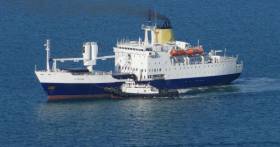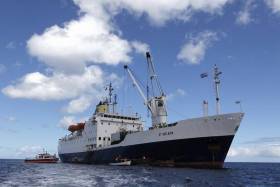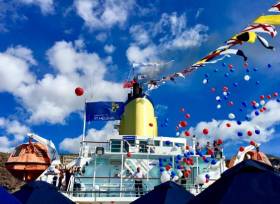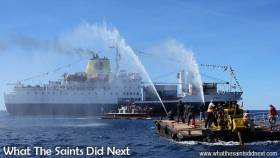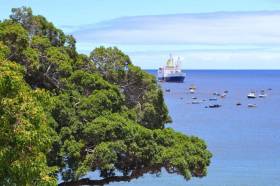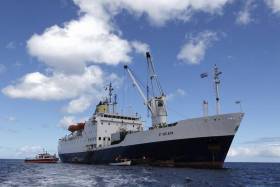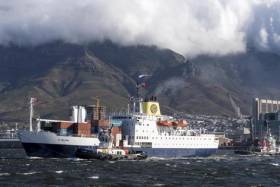Displaying items by tag: RMS St Helena
Formula 1's Lewis Hamilton Creates New Team in Extreme E Which is Converting Former 'RMS' Ship
Formula 1 driver Lewis Hamilton, reports BBC Top Gear, has announced the creation of a new team to compete in the inaugural season of Extreme E with a team called ‘X44’.
Now, Hamilton you might be familiar with (six F1 world championships, really quite handy behind the wheel of an F1 car), and Extreme E you’ve probably heard of too. It’s the off-road series founded by Formula E boss Alejandro Agag, racing identikit electric SUVs in locations across the planet that have been damaged or affected by climate and environmental issues.
Hamilton’s ‘X44’ outfit – a nod to his racing number in F1 – will join a growing list of teams and drivers that currently includes Chip Ganassi Racing, Andretti United, Abt, HWA, Techeetah, and Veloce Racing.
The Extreme E races – in five remote locations – won’t be open to spectators, but there’ll be a live TV broadcast, and the ‘command centre’ will be St. Helena (formerly the Royal Mail Ship RMS St. Helena: which visited Irish waters once) served both as a passenger /cargo ship (to its namesake South Atlantic island) currently undergoing a multi-million Euro transformation.
Afloat.ie adds the conversion work of the former 'Saint' ship is taking place on the other side of the Irish Sea at Cammell Laird, Birkenhead on Merseyside. Also in the UK but earlier in 2016 Afloat secured an invite on board RMS St. Helena during a 'farewell' once off cruise to the Pool of London.
As Top Gear added, it is estimated that using the ship to transport the series around the globe lowers the carbon output by two thirds in comparison to air freight.
For further reading on this new team click here
Also recently announced by Extreme-E is their confirmation of a partnership with the AllCotGroup which is to offset Extreme E’s carbon footprint in support of a goal to have a net-zero carbon footprint by the end of Season 1.
Former Royal Mail Ship (RMS) St Helena Returns 'Again' to UK Waters
#Ports&Shipping - In just over a week of the RMS Leinster centenary ceremony held to commemorate the Irish Sea steamer, another former Royal Mail Ship RMS St. Helena reports the Dorset Echo returned to UK waters after an absence of seven years.
Afloat adds the ship was sold earlier this year to become MNG Tahiti, returned to Portland, Dorset from where the passengership also used to carry goods to the remote island of St. Helena in the South Atlantic Ocean. The ship was spotted arriving into Portland Port by Paul Dallaway this afternoon (last Thursday).
The 6,767-tonne cargo and passenger vessel was once the sole source of supply of all goods for the small island found 1,500 miles north west of Cape Town, South Africa.
It was also one of the last working Royal Mail ships in the world and as Afloat previously reported the 'RMS' as the ship was affectionately called was withdrawn from service earlier this year.
For more on the newspaper's coverage click here
Afloat also adds the RMS St. Helena made a first and only call to Irish ports in 1995 during a charter cruise to Dublin and Cork (Cobh).
On the unique call to the Irish capital, the ship berthed on Sir John Rogersons Quay, along the south quays. Further upriver and on the north banks of the Liffey on Eden Quay, is where the RMS Leinster's operator, the City of Dublin Steam Packet Company's head office was located, see story.
More than two decades later in 2016 the London registered ship finally made a first and farewell call to the UK capital. This was in advance of the ship's withdrawal from service that year of the pivotal island lifeline service, as otherwise this was the only way to reach the island. When introduced in 1990, RMS St. Helena first operated from the UK (Cardiff) to St. Helena, but this changed to the Dorset port.
Delays due to safety concerns of the first airport to be built on St. Helena led to the RMS to continue carrying out south Atlantic voyages. The airport eventually opened to commercial flights and so the final sailing took place in February, marking the end of an era, however a cargo-only ship maintains services.
Former RMS St. Helena to Become Anti-Piracy Armory Vessel
#Ports&Shipping- The UK's last working postal ship, RMS St. Helena, was for nearly three decades the main source of contact between one of humanity’s remotest islands and the outside world.
Now the ship, cherished by the 4,500 residents of British-ruled St. Helena, will according to MarineLink, start a new life as a floating armory, packed with automatic weapons, bullet-proof jackets and night vision goggles, all stored for maritime security operatives.
Renamed the MNG Tahiti, the 340-foot ship will undergo some tweaks before sailing to the Gulf of Oman where it will be used to ferry guns and guards to passing vessels navigating stretches of water lurking with pirates, its new operator said on Tuesday.
For more on the story click here and Afloat's reportage in recent years from London where RMS St. Helena made a first and only farewell call to the UK capital. In addition to highlighting a previous historic once-off 'charter-cruise' to Irish ports in 1995.
RMS St. Helena: What Was It Like to Sail Aboard the Final Voyage
#Ports&Shipping - RMS St. Helena, the last ever Royal Mail Ship completed its last ever journey – and it was surprisingly emotional, says Jonathan Hollins writing in the UK's Independent newspaper.
The word “lifeline” is one too often bandied about and devalued; but, in the case of the Royal Mail Ship St Helena, it is entirely appropriate. In fact, she is its very definition.
For 27 years now, since her shiny new hull first slipped through the murky waters of Cardiff Bay in 1990, the RMS – or “Betty Blue Bucket”, as she is affectionately called – has plied the mid-Atlantic, nurturing Britain’s remote overseas territories and linking them to civilisation. Central to these rocky outcrops is the island of St Helena: sea lashed, cliff bound, the one-time darling of the Honourable East India Company, and haven to over 4,000 “Saints”, as locals are known.
The RMS is the last of her species, the only working royal mail ship left of a fleet that used to string together the distant strands of empire. Two other ships carry the title, but it is only honorary.
The RMS was purpose-built by the UK government, a 105m vessel able to carry 7,000 tonnes of cargo and passengers, all cocooned in a dark blue hull with white topsides, and crowned by a mustard yellow funnel bearing a golden merlion.
Now, however, the fatal day has come. St Helena, formerly the second most remote island in the world, has built an airport, a masterpiece of engineering bedevilled and delayed by topography, and after a two-year reprieve (see Afloat's coverage of once-off London visit) the RMS has completed her final voyage.
For much more on this historic final voyage and photos taken on the momentous day on and offshore of St. Helena Island, click here.
As Afloat reported last October, the passenger-cargoship owners St. Helena Line had appointed the sale of the ship through a London based ship-broker.
Sea transport services will continue albeit with a cargo-only service on the same route operated by A.W. Ship Management. This new service is scheduled to begin tomorrow voyage (No. 1) using the M.V. Helena.
The 'RMS' Returns to St. Helena Due to On Board Emergency
#Ports&Shipping – An emergency on board the Royal Mail Ship RMS St. Helena forced the return of the ship to St Helena Island in the South Atlantic yesterday, writes Jehan Ashmore.
The passenger-cargohip returned to St. Helena, a UK overseas territory, due to an emergency on board, according to the St. Helena Government.
It is thought the emergency involved a sick passenger who was disembarked offshore yesterday morning. Following the transfer and associated operations which took almost two hours to complete, RMS St. Helena made her final bow to St. Helena before resuming service.
The 6,787 gross tonnage ship is currently making the final ever sailing with the return leg of the round trip voyage to Cape Town, South Africa.
The original ‘scheduled’ departure from St. Helena took place on Saturday off Jamestown, the island’s capital amid much fanfare and emotion. St. Helenian’s or ‘Saints’ as they like to call themselves bid farewell to RMS St. Helena for the final time and which involved a flotilla circle the ship in Jamestown Bay.
It was on the proceeding Friday (9 February) – the day having been declared a public holiday by Governor Lisa Phillips, that the main day of the farewell celebrations took place on the Seafront lining the capital that included the RMS’s ‘Crew Parade’
A large crowd turned out to celebrate 27 years’ service of the RMS St Helena (or the ‘RMS’ as affectionately known by the ‘Saints’). Many of the islanders took advantage of the limited free tickets to attend the RMS Open Day and visit the ship for the last time.
Speeches were given by the Governor, Captain Williams, and Director of St Helena Line, Kedell Worboys MBE to highlight the historical signifance of the day. Added to the officiallity, throughout the day entertainment and activities were held for all ages.
Live performances from an Irish duo, the Kudos, and local band, Island Politics, kept the crowd engaged late into the night that was rounded off with a fireworks display. In addition the releasing of Chinese lanterns which lit the night sky above the RMS St Helena which wowed the crowds of onlookers on that historic occasion. For photos and further coverage click here.
The passenger-cargoship, only one of two to hold the title of ‘Royal Mail Ship’ has been a loyal servant in providing a dedicated island-lifeline with the rest of the outside world. Both passengers and cargo having been transferred to and fro by lighters and tenders to Jamestown.
The dynamics of such operations changed dramatically with the opening in October last year of the first island airport that has connecting flights to South Africa through Johannesburg. Such services are a game-changer not only for Saints but a boost to tourism along with business opportunities, however there are those you lament the end of the RMS.
As Afloat previously reported, a cargo-only service by sea will still be maintained when a containership is scheduled to begin service next Wednesday, 21 February. The ship M.V. Helena and operated by AW Ship Management is to make monthly calls at St Helena over a twelve-month period and four calls to Ascension.
RMS St. Helena Makes Final Call to Ascension Before 'Saints' Farewell Celebrations
#Ports&Shipping - According to the St. Helena Government, the passenger-cargoship RMS St. Helena returned to the island following a final round trip to Ascension Island yesterday.
During her call at Ascension and in commemoration of her long and established friendship and partnership with the Island, an Open Day was held onboard the RMS last Saturday, 3 February for 100 visitors. In the afternoon, the ship hosted an official cocktail party where Captain Adam Williams presented a plaque to the Administrator, Mr Nick Kennedy.
The plaque depicts the RMS St Helena crest and is inscribed: ‘Presented to the people of Ascension Island by the Master, Officers and Ratings of RMS St Helena commemorating the final call and 27 years of dedicated and loyal service to this Island – February 2018.’
In his acceptance speech, the Administrator said: “Thank you from everyone on this Island to all the crew of the RMS St Helena. Your hard work and kindness over the years has meant a huge amount to us, as I am sure you will hear from anyone you speak to this weekend. Whatever paths you choose from now on, we wish you every success. You will always have friends on Ascension.”
The plaque will be on display in the Post Office in Georgetown before being moved to the Museum.
Celebrations continued on Saturday evening with a farewell party ashore, hosted by Islanders at the Saints Club in George Town. The party was well attended and was an opportunity for RMS Officers and crew to mingle with Ascension Island residents.
A programme of events for the RMS Farewell celebrations on St Helena began last night.
For further updates and other news from the St. Helena Government click here.
Afloat.ie adds RMS St. Helena will make a historic final sailing with a departure from the remote UK overseas territory in the South Atlantic this Saturday, 10 February.
This will see the ship complete the round trip that had as previously reported had set off last month from Cape Town, South Africa. It is from this country that scheduled commercial flights began operating to the island when an airport was opened for business last October.
A sea connection will still be maintained based on the same route as of the RMS. This will be in the form of cargo-only operations to be operated by containership MV Helena which is to launch this new service on Wednesday 21st February.
The former German ship operated by AW Ship Management is to make monthly calls at St Helena over a twelve-month period and four calls to Ascension.
RMS Ship Runs Out of Steam as St. Helena Island’s Airport takes Off
#Ports&Shipping - RMS St.Helena, the last ship from a mighty fleet that once bound Britain’s scattered empire together will arrive today (Monday, 29 January) after its final voyage to St Helena.
As the UK newspaper, The Times reports the isolated British overseas island territory in the Atlantic Ocean that for hundreds of years was accessible only by sea.
RMS St Helena, one of only two ocean-going vessels that still bear the title “Royal Mail Ship”, will end a final five-day journey from Cape Town, South Africa (haven departed last Wednesday) The unique occasion has been marked by pipe bands, ceremonies and an outpouring of nostalgia.
A flotilla of small boats, the British governor and a huge crowd will greet the ship as she anchors in the bay off Jamestown, the capital.
There will be parties aboard and tours of the ship that for 27 years was the island’s only…to read more click here. Note registration is required to continue further reading of the story.
Afloat.ie can update to confirm according to AIS tracking, that the St. Helena Line passenger-cargsoship is currently at anchorage offshore of the remote island. Next month the only scheduled sea connection will be served exclusively by a cargo-only containership.
During a reception held on board the RMS St. Helena's final (and only) farewell visit to London in 2016, the topic of the ship's replacement was discussed with Afloat from representatives of AW Ship Management. It was disclosed then that a German containership would be taken under contract to continue St. Helena operations based out of Cape Town and also maintain serving Ascension Island. The ship in question is the former Eemslift Christian, renamed Helena which is to begin the new cargo-only service. More on this to appear on Ports & Shipping news.
As for the Islanders or 'Saints' as they call themselves and tourists alike, they have since October last year had the option of taking commercial flights to and from South Africa to the island's first ever airport. The facility caused much controversary given delays arising from safety concerns of aircraft using the runway but were finally resolved. The airport is a game-changer in terms of tourism opportunities and developing new business links.
Among a programme of events to mark the historic farewell voyage on St. Helena, according to the island Government's website will start next week on Tuesday, 6 February, with a Thanksgiving Service at St James’ Church. The service starts at 7pm and all are invited to attend. Following the service the RMS crew will proceed to the Seafront for a Blessing.
A special RMS Open Day will be held on Friday, 9 February, which will allow the Saints a final opportunity to view the ship based on those who have already made a booking. The public viewing will permit access to the bridge overlooking the cargodeck, the passenger facilities and several cabins. Invariably this will prove to be an emotional day.
Celebrations on the Seafront will start at 3pm and will include a local market, RMS entertainment, an exciting performance by the RMS Amateur Dramatics Society and live music by various local bands. Festivities will continue until midnight.
The RMS St. Helena will depart for the very last time when a final voyage from St. Helena is on Saturday, 10 February and returning to the South African port. This will truly be an end of era not just for the Saints but as part of world maritime history.
Royal Mail Ship Embarks on Final Voyage to St Helena
#Ports&Shipping - RMS St Helena, a UK flagged Royal Mail Ship as previously reported on Afloat, that was once a lifeline to the outside world for St Helena is making its last voyage to the remote South Atlantic island where Napoleon died in exile.
According to Gazette News, RMS St Helena’s route for the last three decades is being phased out because a South African airline started a weekly commercial flight in October after the delayed opening of an airport on the volcanic island, and flights could become more frequent if there is demand.
Until last year, the “royal mail” vessel had been the only regular way to reach British-ruled St Helena for passengers who spent nearly a week at sea after departure from the South African city of Cape Town.
Ahead of the ship’s final departure from Cape Town on Wednesday, diplomats, tourism officials and crew members mingled at an on-board reception.
To read more of this historic farewell unique passenger-cargo voyage and photos click here.
End of an Era As Unique Passenger-Cargoship RMS St. Helena Prepares to Bid Farewell
#Ports&Shipping - The unique Royal Mail Ship, RMS St Helena (see related ship for sale report), will depart on a final voyage from the remote South Atlantic island of St. Helena on Saturday, 10 February, having dutifully served for the past 27 years.
The island, a UK Overseas Territory located 1200 miles off the west coast of Africa could only be reached by the ocean-going passenger-cargsoship service, until commercial flights began operating last October, following completion of an airport.
There are two other ships that still carry the legacy ‘Royal Mail’ designation, however the uniqueness of RMS St Helena, is because the 6,767 gross tonnage ship, is the only remaining Royal Mail Ship contracted by the UK's postal service to carry mail across the seas.
Preparations to bid farewell to the RMS are underway and a working group comprising of representatives from St Helena Line, the RMS, SHG, St Helena Tourism, Solomon & Company (St Helena) Plc and Legislative Council has been established to take forward the celebrations and ensure the RMS gets the ‘send off’ she deserves.
A programme of events has been put together which starts when the RMS is in Cape Town, South Africa. The ship will host a cocktail party onboard for invited guests before sailing on her last voyage from Cape Town on Wednesday, 24 January. The RMS will sail from ‘F Berth’ where the Cape Town Caledonian Pipe Band, dignitaries and others will be able to wave goodbye to the vessel.
Director of St Helena Line, Mrs Kedell Worboys MBE, will also present Captain Adam Williams with a 27ft ‘paying off’ pennant, to mark the 27 years’ service of the RMS St Helena – the pennant will be flown from the RMS mast as she sets sail from Cape Town.
During the RMS’ visit to Ascension Island on Saturday, 3 February, the ship will host a cocktail/drinks party for invited guests.
The RMS arrives at St Helena on Tuesday, 6 February, when the on-Island activities for her farewell begin.
A service of thanksgiving will be held at St James’ Church for RMS crew – this will conclude with a procession to the Sea Front. Members of the public will be invited to attend.
A ‘memory wall’ will be placed in various locations throughout the week for members of the public to share their memories of the RMS.
The main celebrations will take place on Friday, 9 February, with an RMS Open Day and celebrations on the Sea Front. Prior bookings will be taken for the Open Day and further details will be released shortly. Celebrations will include an exciting performance by the RMS Amateur Dramatics Society and live music by various local bands.
Passengers travelling on the final voyage (no. 268) will be treated to celebrations onboard the ship and able to listen to a live broadcast of the festivities taking place ashore.
The public will have a chance to say goodbye to the RMS crew on Saturday, 10 February, when all crew members in their uniforms proceed from the Grand Parade in Jamestown, through the Arch, making their way along the Sea Front before returning to the ship.
The RMS will depart St Helena at 4pm on Saturday. The 27ft paying off pennant will be walked from the Sea Front to the bottom steps where Kedell will once again present the pennant to Captain Williams. Members of the public will be allowed access to the bottom steps to witness this and to say a final farewell.
It is planned for a flotilla of boats to circle the harbour and the RMS St Helena before she pulls up anchor. Captain Williams will then sail towards Buttermilk Point before turning around for a steam past the harbour, allowing all ashore to view the RMS for one last time decked out in full dress and to view the 27ft paying off pennant. The RMS will then stop at Lemon Valley where her flags will be taken down before continuing her onward journey to Cape Town.
Further details of the programme including times and details of various competitions will be published in the coming weeks. Members of the working group will also be on local radio informing the public of celebrations taking place.
It is hoped that the community will come together to give the RMS St Helena an unforgettable send off.
Operator to Withdraw RMS St Helena from Unique South Atlantic Service Seeks Buyer for Passenger Cargoship
#RMSstHelena - Operators of one of just four of the world's surviving Royal Mail Ships, St Helena Line has announced today, that it is to withdraw the passenger cargoship RMS St Helena from service in February 2018. The ship has been appointed to London ship broker CW Kellock & Co Ltd who are to handle her sale.
As previously reported Afloat made a unique visit on board the RMS St. Helena in London last year, a historic once off visit to the ships homeport, having sailed from the south Atlantic Ocean island of St. Helena, one of the most remote places in the world. The ship was making a farewell visit to the UK and notably made a previous cruise-charter visit to Dublin during the 1990's.
Operated by St Helena Line Ltd (SHL) on behalf of the St Helena Government (SHG), the RMS has been part of the Island’s history for over quarter of a century and provided the sole regular means of access to the Island, a remote UK Overseas Territory located 1200 miles off the West coast of Africa in the South Atlantic.
She was built in the UK in 1990 specifically for the St Helena route. At 6,767 gross tonnes, she can accommodate 156 passengers in 56 cabins, together with a cargo capacity of 3750 cbm bale, and 92 teu (of which 17 reefer). She is staffed by 56 officers and crew.
The RMS St Helena is one of only four ships left in the world which has the right to carry the Royal Mail Ship (RMS) prefix. The RMS currently operates out of Cape Town calling at both St Helena and Ascension Island on a regular schedule.
With the start of scheduled passenger flights to St Helena on 14 October 2017 providing the main passenger access to the Island, the RMS St Helena will be withdrawn from service.
The RMS St Helena is now embarked on her final programmed voyages and in the coming weeks will make a farewell call to Tristan da Cunha and then a final voyage to both St Helena and Ascension Island. She is expected to finish her last voyage in Cape Town on 15 February 2018.
SHL has appointed the highly experienced London ship brokers CW Kellock & Co Ltd (Part of the Eggar Forrester Group), to handle the sale and it is hoped that a buyer can be found to continue to trade the vessel elsewhere in the world.
Commenting on the sale process and her withdrawal from service, SHL’s Chairman, Matt Young, said: “The RMS St Helena has played a vital role in sustaining St Helena’s population and, for the past 27 years has been the sole means of regular access to the Island.
“Her combined passenger accommodation and cargo design makes her well suited to a number of different trading options and we are confident that she can continue to play an important role elsewhere in the world.”



























